Introduction
On 7 November 2023, the Geneva FP&A Board had its 15th meeting in the beautiful co-working SPACES Quai de L’ile office in the city centre of Geneva. This FP&A Board attracted 40 finance practitioners from leading companies such as General Mills, Honeywell, The Economist Group, JTI, Unilabs and many others to exchange experiences and views on the subject dedicated to FP&A Storytelling in a Data-Driven World.

Figure 1: Geneva FP&A Board №15, November 2023
Per established tradition, the meeting was chaired by Larysa Melnychuk, Managing Director of the International FP&A Board, who steered the passionate discussion over this vast yet challenging topic with professionalism and care.
The meeting was sponsored by Wolters Kluwer/CCH Tagetik in partnership with IWG, Michael Page and Page Executive.
FP&A Storytelling in Detail: Components, Challenges and Insights
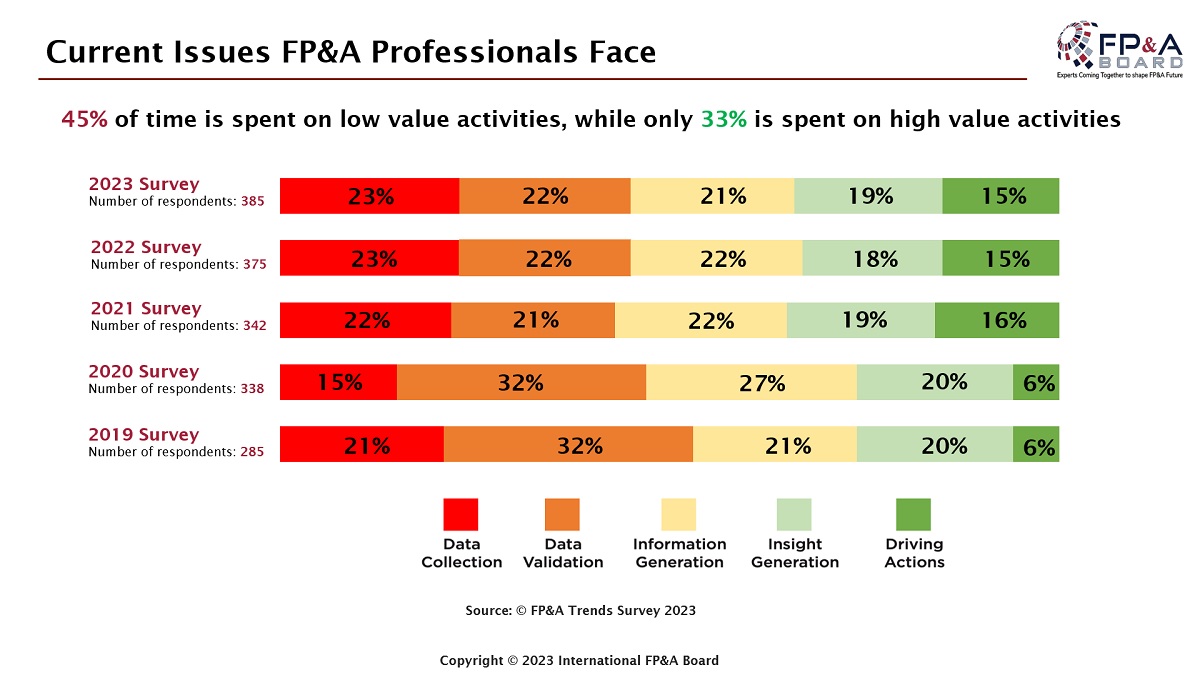
Figure 2
According to the FP&A Trends Survey 2023 results, finance professionals spend only 34% of their time generating insights and driving actions. This is because 45% of the time is still devoted to non-value-adding activities, like data extraction and validation.
In an attempt to define the critical factor for the success of FP&A Storytelling in a single word, the participants expressed the highest preferences for the terms “insights”, “impact”, “influence”, “simplicity”, “audience knowledge”, and “narrative”. In summary, Larysa Melnychuk defined FP&A Storytelling as
“the process of turning financial and non-financial data into a powerful story that builds trust, aligns teams, and drives decisions in business”.
The forum transitioned to the subject and explored the impact of Artificial Intelligence (AI) on FP&A Storytelling. The first question discussed was: “Can the latest technology developments, notably AI, replace FP&A Storytelling?”.
Pasquale della Puca shared his view that although technology can partially replace data generation and message creation, it cannot substitute decision-making. The prevailing opinion was that traditional FP&A Storytelling would not disappear but would rather be supported with data generated through the latest technology.
Meeting participants then focused on the three core pillars of the FP&A Storytelling:
- Narrative,
- Visuals,
- Data.
1. Narrative
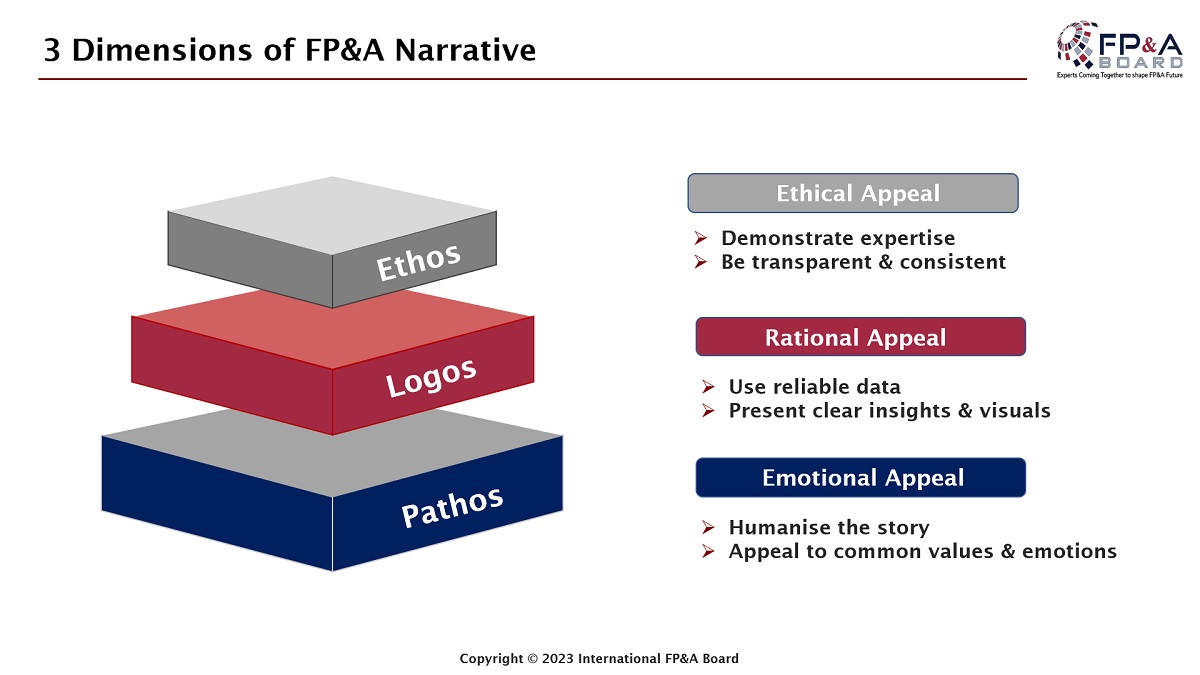
Figure 3
Defined by Larysa Melnychuk as “the blueprint of a story”, the narrative is the script of FP&A Storytelling that triggers differing opinions. It is a three-dimensional pyramid, with ethical (expertise, transparency, consistency), rational (data, insights and visuals) and emotional (common values and emotions) aspects which are intertwined.
Olivier Demierre believes one can tweak the message in the desired direction, so maintaining a high ethical standard is important for an FP&A Storyteller. Moussa Cissoko thinks that for a finance professional who is a true business partner, there will always be ways to deliver the message appropriately by having the CEO onboard and keeping a strong relationship with the team.
As per Anna Fastishevskaya, one must always tailor the message accordingly to the audience to achieve the desired communication result. Elif Imer shared her experience when she was taking over a new position and realised that no FP&A professional within the team owned the data building and story creation. Growing a team member with this profile helped her gain the stakeholders' appreciation and trust. According to Julien Barbedette, Scenario Planning with options, in which logic is individually described, should be the foundation of FP&A Storytelling. Olivier Demierre and FD at the Economist added that the storyteller should always lay out the underlying assumptions for better impact. Dev Mertia opened a new perspective by adding that finance professionals need to present the alternatives but leave the option to contribute to the final decision for others.
Anna Fastishevskaya challenges the traditional expectation of finance storytelling to be based on hard facts and data only. She suggests that intuition has a role to play as it is usually based on prior experiences that come up as unconscious due to time pressure and situational uncertainties. And it is the combination of both rational approach and intuition that gives the best results.
Finally, for Tal Volok, FP&A Storytelling is the culmination of a process where the storyteller obtains the stakeholders' perspectives and reaches a consensus with them in advance.
2. Visuals
The participants continued their exploration with the second element of FP&A Storytelling – visualisation.
Larysa Melnychuk shared that in her experience, great and sophisticated visualisation is not always appreciated by the audience as it can be quite overwhelming. Christine Fromont added that “know your audience” and “less is more” principles are key to delivering effective visuals. Julien Barbedette concluded that adjusting the visualisation mode according to the message, which needs to be conveyed, shall be the key concern for the storyteller.
3. Data
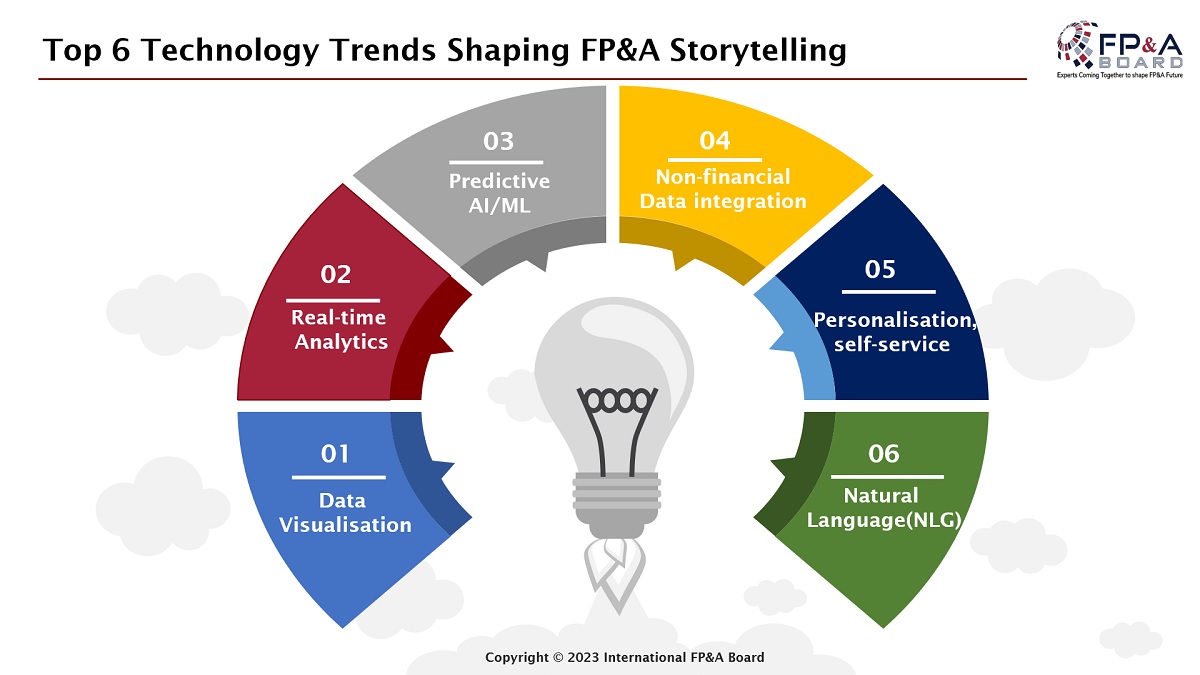
Figure 4
The forum also made an overview of the top 6 technology trends shaping FP&A Storytelling:
- Data Visualisation
- Real-time Analytics
- Predictive AI/ML
- Non-financial Data Integration
- Personalisation, Self-service
- Natural Language
Consequently, the agenda moved into a discussion of “How do FP&A storytellers select and validate the most impactful data points to drive their narrative and visualisation effectively?”. Due to the diverse backgrounds, industries, and experiences of the Board members, there were plenty of different views and varying opinions without a prevailing recipe.
This part concluded with input by Charlotta Gosschalk about her experience with applying Driscoll’s Model of Reflection with its 3 stages: What? So What? Now What? As business leaders are overwhelmed with numbers and receive many presentations, the key question is how to grasp the audience’s attention and manage their short attention span. In her experience, the best way to achieve this goal is to always start with the summary of the recommendations before going into more detail and support the presentation with a pre-read containing detailed information.
Group Work
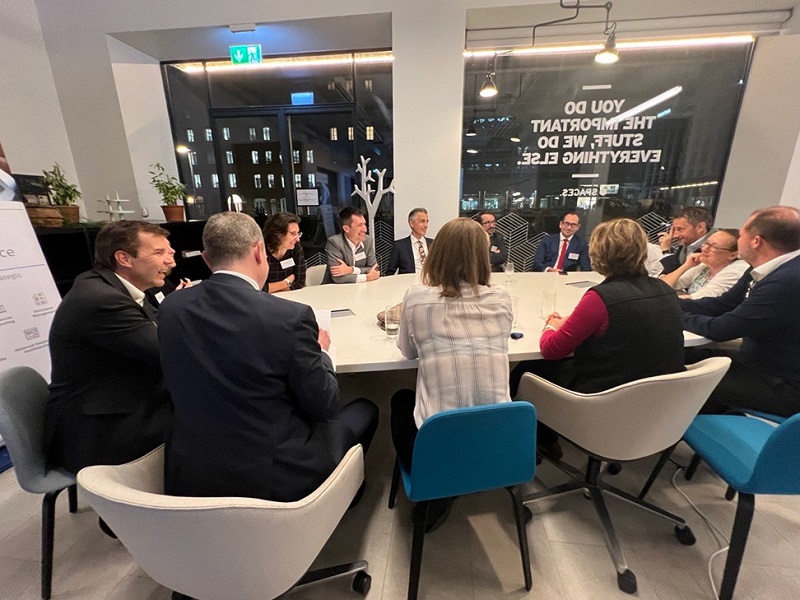
Figure 5: Group Work, Geneva FP&A Board №15, November 2023
Closer to the end of the meeting, the Board moved towards Group Discussions to elaborate on the practical steps enabling compelling FP&A Storytelling.
The recommendations of each group were summarised as follows:
How to create a clear, engaging narrative tailored to our audience?
- Create an emotional connection with the audience.
- Keep them engaged - make a funny joke or share a provocative fact.
- Rehearse the presentation, prepare and send a pre-read to participants.
- Be crisp and concise; adopt your voice and tone according to the message.
- Triangulate the information presented from multiple sources.
How to design impactful, comprehensible visuals for our story?
- Explore the data with the narrative in mind.
- Mock up a few ideas and share them to get feedback for the most compelling ones.
- Circle back to the narrative and adjust, if needed, to fit the chosen visualisation.
- Create and promote self-service boards whenever possible.
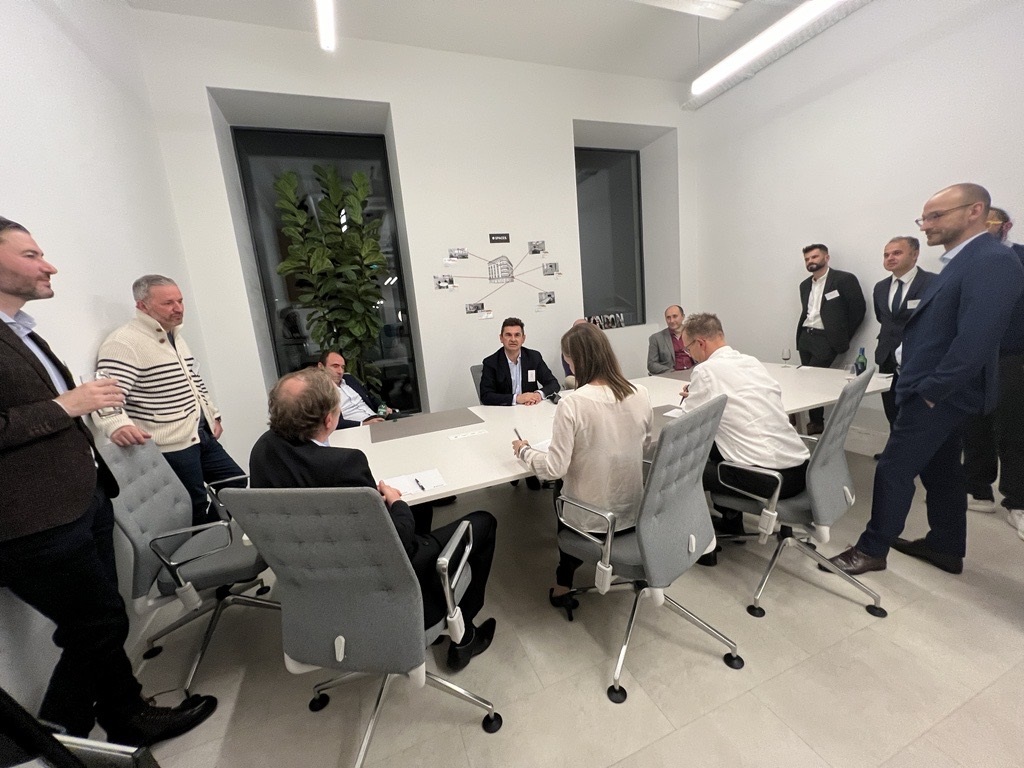
Figure 6: Group Work, Geneva FP&A Board №15, November 2023
How to effectively identify and analyse relevant data for our narrative?
- Carefully select the data according to defined comparatives and the chosen narrative.
- Define key data drivers and check data accordingly.
- Explore data from various angles to discover possible interesting trends.
- Generate multiple ratios and KPIs and choose the ones that best support the narrative and contribute to the storytelling process.
Key Takeaways
In the current environment, business leaders are bombarded with all sorts of data and overwhelmed with excessive and contradictory information. It turns decision-making into a painful, time-consuming, and resource-draining exercise. However, we should not perceive it as a threat.

Figure 7: Networking, Geneva FP&A Board №15, November 2023
This presents an excellent opportunity for all the finance community members to rise to the challenge and master the art of the storytelling process by defining the audience, crafting the story, adding credibility, and bringing passion to the process. This was the winning formula for FP&A Storytelling defined at this FP&A Board. Elevating their FP&A Storytelling skills would confirm their key business partnering role in providing invaluable support to the senior leadership and effectively steering future strategic decisions.







